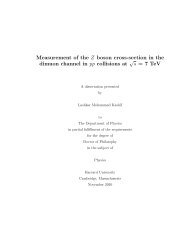2 The CDF Experiment at Fermilab Contents - Harvard University ...
2 The CDF Experiment at Fermilab Contents - Harvard University ...
2 The CDF Experiment at Fermilab Contents - Harvard University ...
You also want an ePaper? Increase the reach of your titles
YUMPU automatically turns print PDFs into web optimized ePapers that Google loves.
50 Section 2: <strong>CDF</strong> Physics Analysis<br />
GeV. This requirement is 95% ecient for tt events while removing most of the soft lepton<br />
tags arising from Drell-Yan, Z or upsilon production which are quite isol<strong>at</strong>ed. Secondly, we<br />
extended the Method II background calcul<strong>at</strong>ion to the SLT tagged sample. In order to do<br />
this correctly, we subtracted from the raw fake tag r<strong>at</strong>e the fraction ( 10%) associ<strong>at</strong>ed with<br />
real heavy avor jets.<br />
<strong>The</strong> third technique is called the \jet probability" tag. This algorithm uses the impact<br />
parameter of a track contained in a jet to determine the probability the track origin<strong>at</strong>es from<br />
the primary vertex, given the SVX detector resolution. <strong>The</strong> combin<strong>at</strong>ion of the probabilities<br />
of all tracks in a jet gives an overall probability for the jet, i.e., the jet probability or \JPB."<br />
For heavy avor jets, this probability is expected to be small.<br />
Our requirement on JPB is loose in the sense th<strong>at</strong> the eciency for b-jets is about the<br />
same as SECVTX, while about twice the number of c-jets is accepted. Since the overlap<br />
of JPB and SECVTX is large, this new algorithm does not bring much new inform<strong>at</strong>ion in<br />
terms of b-quark tagging. However, the loose JPB tags are more sensitive than SECVTX to<br />
backgrounds from mistags and c-quark jets, a fact which we have exploited to study these<br />
important backgrounds. From these studies we uncovered and corrected some inconsistencies<br />
and mistakes in the standard Method II background calcul<strong>at</strong>ions developed for SECVTX<br />
tags. We also showed th<strong>at</strong> the eciencies for SECVTX were underestim<strong>at</strong>ed by 25% rel<strong>at</strong>ive<br />
by studies of the low-P T inclusive electron sample. In contrast, the resolution functions<br />
required by JPB are derived separ<strong>at</strong>ely for d<strong>at</strong>a and Monte Carlo, leading to a rel<strong>at</strong>ively<br />
reliable performance.<br />
<strong>The</strong> problems with the SECVTX eciency led us to re-evalu<strong>at</strong>e the r<strong>at</strong>e of gluon splitting<br />
to b b and cc pairs, important for estim<strong>at</strong>ing the amount of W + b b and W + cc background.<br />
Before correcting SECVTX b-tagging eciency, we had found inconsistent results<br />
from SECVTX and JPB. Applying the correction, however, the two algorithms gave identical<br />
results. This lends credence to the SECVTX eciency correction we derived.<br />
We developed a new technique for explaining and determining the amount of SECVTX<br />
and JPB mistags using the characteristics of JPB. Our simple model successfully predicts<br />
the r<strong>at</strong>e and kinem<strong>at</strong>ical distributions of instrumental backgrounds with better than 10%<br />
accuracy is superior to the method developed in the old analysis. It also allows for an<br />
improved understanding of the heavy avor tagging and the mechanisms contributing to the<br />
neg<strong>at</strong>ive tagging r<strong>at</strong>e.<br />
Based on the new techniques and the extended background studies described above,















